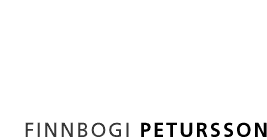|
|
![]()
Iceland Review
Finnbogi Petursson must rank today as one of Iceland’s most innovative and exciting artists, whose explorations are at the forefront of art in the digital age. Using sound, light and materials, Petursson’s works combine different branches of the arts to extend the questions about time, space and existence which modern art must always strive to resolve. Petursson was born in 1959 in Reykjavik and educated at the Icelandic College of Arts and Crafts in the capital. From there he followed the “Dutch connection” to the Jan Van Eyck Akademie in Holland.
One of his early pieces, a joint project with the Dutch artist Leidi Haaijer, consisted of 25 stereo tape decks and 750 gold painted wooden chairs. Titled Situation, sounds of human voices and reproductions of a Gregorian chant and ringing bells were relayed through loudspeakers located inside the Dominicane church in Maastricht. Also in 1985, Petursson set up a sonic composition called Waves — three V-shaped aluminum rods, which struck repeated blows against the walls of the exhibition room. The blows and their echoes were amplified and rotated through 12 loudspeakers in another hail.
From the beginning, Petursson’s work has been noted for its simplicity while another feature is that hardly anything on the technical side is concealed: wires and cables, plugs and mountings are inseparable to the finished work and are therefore allowed to be visible. Installations continued when Petursson returned to Iceland in the late Eighties and established the loudspeaker as his favorite medium in spatial conceptions which he terms “sound drawings.” One of his most remarkable pieces was at the Living Art Museum in Reykjavik in 1991. Called Circle, the work comprised a single loudspeaker suspended over a darkened trench filled with water. Sine waves from 0-200 hz were emitted which rippled the water and, as the surface changed with the pitch, the circular patterns were projected on to a wall.
With sound and noise being so integral, it is desirable that Petursson’s work are seen — and heard — in situ, or at least on video, of which at least two are currently available. For despite their highly technical nature and execution, Petursson’s works focus on giving the viewer/listener an experience verging on the spiritual. It is an experience that many art enthusiasts wish to undergo, judging by the number of galleries around the world anxious to show Petursson’s work.
- Richard Middleton, 1999
|
